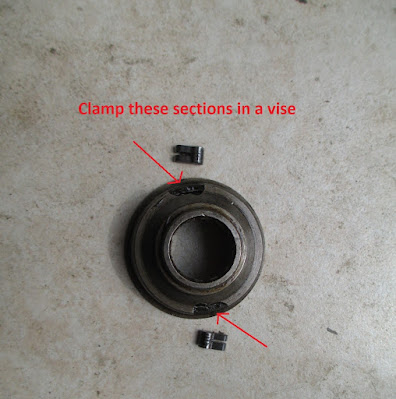It's time to build something a little different. The white Schwinn Traveler that I repainted was in pretty rough shape, and I want to rebuild it without spending a lot of money. Its front derailleur was the wrong clamp size, and used a rubber shim to secure it to the seat tube. The rear derailleur was corroded and in bad shape (I think this bike was left outside for years). Instead of trying to find replacements, let's just do away with them both.
To make a singlespeed conversion you first need a singlespeed freewheel. In the past I used inexpensive Dicta freewheels, but new bike parts are getting rather expensive now. I happen to have an old 5 speed Normandy freewheel with a worn out 14 tooth sprocket. Using a pair of chain whips I was able to unscrew both the 14 tooth and 17 tooth sprockets from the freewheel body. After sliding off the remaining sprockets, I reassembled this freewheel with three spacers behind the 20 tooth sprocket. Since this sprocket is splined, I screwed the 17 tooth sprocket back on to hold everything in place:
This setup is a little bit heavier than a proper singlespeed freewheel, but the goal here is cheap.
Next it's time to look at the front part of the drivetrain. After removing the 52 tooth chainring there is an issue with the chainring bolts:
You can buy shorter chainring nuts and bolts to fit a single chainring. However, that costs money so that's not an option for this build. Instead I can grind the nuts down to make them shorter. An even easier option is installing 10mm or 3/8" washers in place of the large chainring. These washers will take up the slack and allow me to fully tighten the bolts.
I ended up having to grind a flat side on each washer so they could fit properly on the crank spider, but that only took me a few minutes. With all the washers in place, the chainring could be securely installed:
The chain needed to be shortened, so I loosely installed the rear wheel and looped the chain around both sprockets in order to find the right length. Since this frame has horizontal dropouts, there was a lot of room to adjust the chain length:
Getting the chain to run straight between the front chainring and the rear freewheel is the main concern when you convert a bike to singlespeed. To accomplish that, I simply moved the 40 tooth chainring back to its original location on the inside of the crank spider. This provided a nice straight chainline:
After reassembling the rest of the bike I spent a slightly painful amount money on new handlebar tape. The drivetrain isn't the prettiest, but this bike rides quite nicely.




































